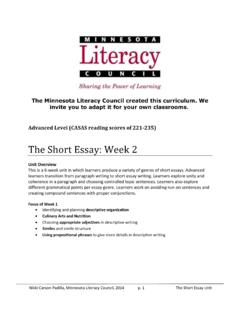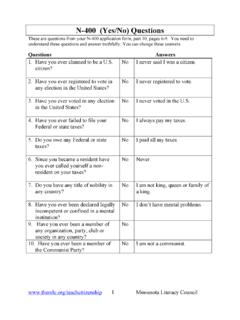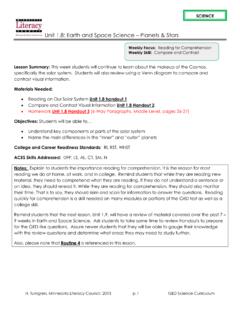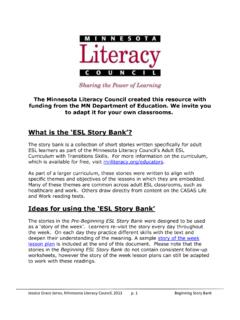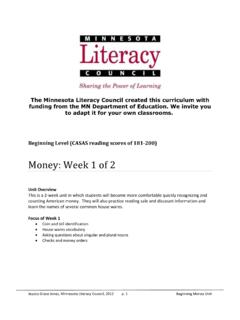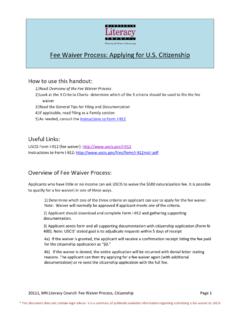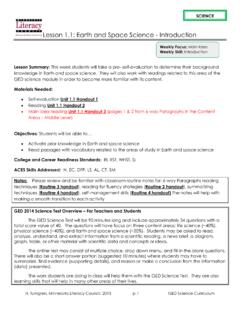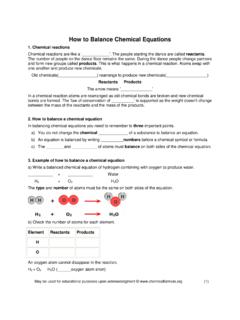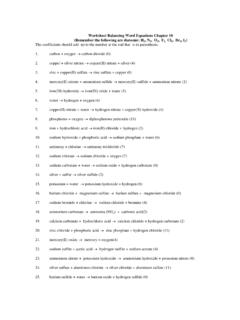Transcription of Lesson 2.7.2: Physical Science Chemical Reactions Part 3 ...
1 Lesson : Physical Science Chemical Reactions part 3: balancing equations H. Turngren, Minnesota Literacy Council, 2014 GED Science Curriculum Science Lesson Summary: This week students will continue with a more in depth look at Chemical Reactions with a comprehension reading and then use mathematical concepts to balance equations . Note: This Lesson requires some algebraic problem solving, if students are new to this type of mathematical work, it may take some time for them to become acquainted with the material. Please be prepared to assist. Materials Needed: Reading with comprehension questions Unit Handout 1 Video Unit balancing Chemical equations (3:25 min) Practice Unit Handout 2 (The video may need to be played a few times.)
2 Be prepared with the extra handout (Unit Handout 4) for assistance.) Extra Work/Homework Unit Handout 3 Objectives: Students will be able Activate prior knowledge and review previous material in Physical Science related to Chemical Reactions Begin to work on the math concepts in Science related to balancing Chemical equations College and Career Readiness Standards: RI, RST, WHST, SL ACES Skills Addressed: EC, LS, ALS, CT, SM, N Notes: Please review and be familiar with classroom routine notes for: reading for fluency strategies (Routine 2), summarizing techniques (Routine 4), self-management skills (Routine 1). The notes will help with making a smooth transition to each activity. GED 2014 Science Test Overview For Teachers and Students The GED Science Test will be 90 minutes long and include approximately 34 questions with a total score value of 40.
3 The questions will have focus on three content areas: life Science (~40%), Physical Science (~40%), and Earth and space Science (~20%). Students may be asked to read, analyze, understand, and extract information from a scientific reading, a news brief, a diagram, graph, table, or other material with scientific data and concepts or ideas. The online test may consist of multiple choice, drop down menu, and fill-in-the-blank questions. There will also be two short answer questions (suggested 10 minutes each) where students may have to design an experiment or identify errors in a conducted experiment, summarize, find evidence (supporting details), and reason or make a conclusion from the information (data) presented. The work students are doing in class will help them with the GED Science Test.
4 They are also learning skills that will help in many other areas of their lives. Weekly Focus: Comprehension Weekly Skill: Math Concepts in Science Lesson : Physical Science Chemical Reactions part 3: balancing equations H. Turngren, Minnesota Literacy Council, 2014 GED Science Curriculum Science Activities: Warm-Up: Journal Writing Time: 5 - 10 minutes As students enter the class, Write on the board What is the difference between endothermic and exothermic Chemical Reactions ? Ask students to write about this in their notebooks or journals. This is an opportunity for students to recall information from the readings and Science experiments from the last few lessons regarding Chemical Reactions . Activity 1: balancing Chemical equations Reading Passage (Unit Handout 1) Time: 35- 40 minutes 1) Hand out Unit Handout 1 to students.
5 2) Discuss with students that when reading, they should pay close attention to what all of the passage is about. This passage has a connection to ideas and information about Chemical Reactions . 3) Ask students to read the passage and answer the questions that follow. Circulate the class while students are working independently to help as needed. Remind students to review the guide words in bold on the left to help with new vocabulary. 4) When students are finished, review answers as a whole class. 5) Ask for students to share their answers if they would like. If there is time, you may have students practice reading for fluency and read the passage to each other in pairs. Break: 10 minutes Activity 2: balancing Chemical equations Hands on practice (Unit Handout 2) Time: 50 - 55 minutes 1) Hand out Unit Handout 2 to students.
6 Explain to them that since they have been reading and conducting experiments about Chemical Reactions , it is time to move to the next step with Chemical Reactions , which is incorporating mathematical concepts into balancing equations . 2) Discuss with students that the concept of balancing Chemical equations requires careful attention to details and some algebraic thinking. 3) Have students read the first part of the handout. Then, show the video. 4) Explain to students while they are watching the video, they have to fill in some areas of the handout. You may need to pause and replay some parts of the video. 5) Review the answers with the class to make sure they understand the basics of balancing equations . 6) Do a few of the equations on the handout to demonstrate/model to students, and then do a few together as a class.
7 Finally, have students work alone or in groups to solve the problems. 7) Review their answers as a whole class. (If possible ask students to solve problems on the board or explain how they did the work.) Lesson : Physical Science Chemical Reactions part 3: balancing equations H. Turngren, Minnesota Literacy Council, 2014 GED Science Curriculum Science Wrap-Up: Summarize Time: 5 minutes Have students turn to a partner (or write in their journals) about what they have learned today from balancing Chemical equations . Ask them to tell a partner how they went about balancing the equations from the handout. Note: Use Routine 4 Handout Extra Work/Homework: Unit Handout 3 Time: 30 minutes outside of class Students can continue with balancing Chemical equations with the one page handout.
8 Differentiated Instruction/ELL Accommodation Suggestions Activity If some student groups finish early, they can turn their paper over and summarize the reading passage. Handout 1 Online Resources: Online Chemical equation balancing quiz - Suggested Teacher Readings: GED Testing Service online free Science practice test (to get an idea of test questions there is no grading on this practice test and there are no answers given) GED Testing Service GED Science Item Sample (to get an idea of what the test may be like) free online practice tests Practice Test B is for GED 2014 (Practice Test A is for older version of test) students can get a feel for what the online test is like. Assessment Guide for Educators: A guide to the 2014 content from GED Testing Service: Minnesota is getting ready for the 2014 GED test!
9 Website with updated information on the professional development in Minnesota regarding the 2014 GED. Lesson : Physical Science Chemical Reactions part 3: balancing equations H. Turngren, Minnesota Literacy Council, 2014 GED Science Curriculum Science Essential Education s 2014 GED Test Curriculum Blueprint (PDF) Lesson : Physical Science Chemical Reactions part 3: balancing equations H. Turngren, Minnesota Literacy Council, 2014 GED Science Curriculum Science Unit Handout 1 (4 pages total) Lesson : Physical Science Chemical Reactions part 3: balancing equations H. Turngren, Minnesota Literacy Council, 2014 GED Science Curriculum Science Lesson : Physical Science Chemical Reactions part 3: balancing equations H.
10 Turngren, Minnesota Literacy Council, 2014 GED Science Curriculum Science Lesson : Physical Science Chemical Reactions part 3: balancing equations H. Turngren, Minnesota Literacy Council, 2014 GED Science Curriculum Science Lesson : Physical Science Chemical Reactions part 3: balancing equations H. Turngren, Minnesota Literacy Council, 2014 GED Science Curriculum Science Unit Handout 1 TEACHER ANSWER KEY 1. Chemical equation 2. Arrow 3. Mass 4. Synthesis 5. Decomposition 6. Single replacement 7. Double replacement 8. Combustion 9. Synthesis, decomposition, single-replacement, double-replacement, combustion 10.
